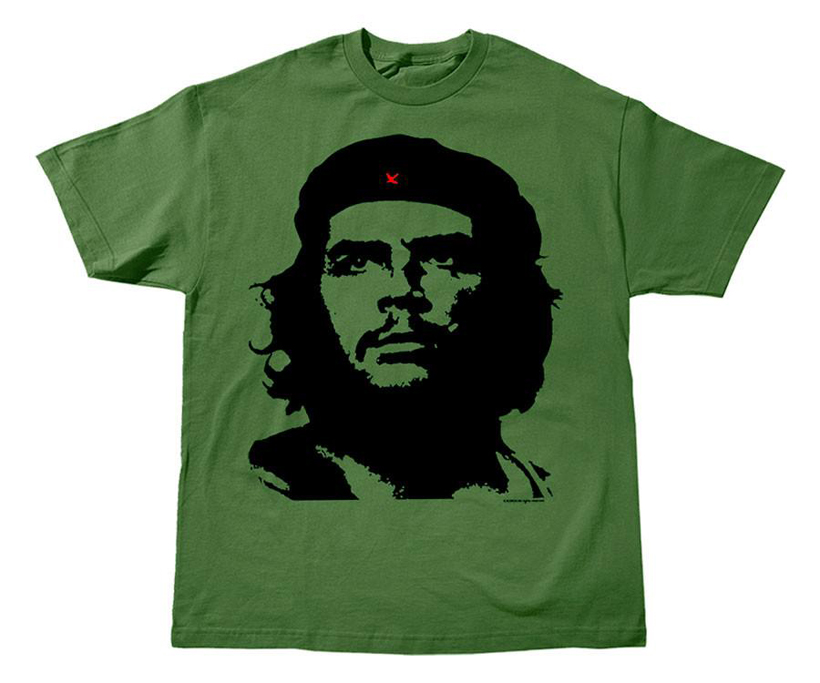We all own a bit of clothing history
Embraced by music lovers, activists and campaigners, political parties and advertisers. A tshirt can say so much about our connection with the world and fashion, our musical and social tastes. We all own and create a little bit of its history.



The Banner of all Assertions
From an item of underwear, the tshirt has become a standard wardrobe item. Initially common among members of the military below the uniform, the tshirt burst onto the scene popularised by screen heartthrobs Marlon Brandon and James Dean.


Delving into its commercialisation since World War 2, it has been popularised on screen, by music, through politics and in advertising.
In his book “1000 tshirts that make a Statement”, Raphaelle Orsini labels the connection between music and tshirts “an eternal love story”. Musicians, bands albums and songs have all been immortalised on tshirts, from punk to metal through pop rock and hip hop. Music festivals are also a source of invention and a huge retail market.
Campaigning – tshirts for a noble cause
Politics and activism have provided a rich source of content for tshirts. Interestingly the iconic image of the Cuban revolutionary Che Guevara was never copyrighted as the Communist regime believed it as a bourgeois concept.



The Obama “Hope” image (created for the 2008 campaign by Shepard Fairey) was just one of many political images to adorn a tshirt; tracing a history back to Thomas Dewey’s unsuccessful 1948 presidential campaign of 1948 against Harry Truman when it was first tried in politics.
Tees – a dream advertising tool
Advertisers were drawn to it as a cheap, easy, visible promotional tool. The tshirt is probably responsible for the death of the sandwich board!
Milton Blazer, the graphic designer, who created the “I love NY” slogan, concurs that the tshirt is a powerful, personal tool of protest. He gave the rights away for nothing for the slogan which was meant to be a short-term campaign but is now copied by cities across the globe.


The Numbers Game
On a personal level, I must mention the sports top as one of the most famous variations of the tshirt. These days football tops are worn like a second skin; a totemic, emotional object.
Even the numbers have become synonymous with legendary players: Moore 6, Best 7, Dalglish 8, Jordan 9 and the ultimate, modern numerical disrupter, Johan Cruyff who consecrated the number 14 shirt; the first ever footballer to cement any number beyond 11 in the my mind.
Like many a football-mad kid of the 70s, I got my mum to make and sew the iconic number 10 onto the back of my yellow and green tshirt to impersonate my new idol, Brazilian No10 Pele.
Then the block yellow and red kits of Pele and Moore gave way to new innovative new designs – pioneered by manufacturers like Admiral. Trims, collars, home and away strips, the influx of exotic foreign players, team sponsorship and colour TV dramatically ramped up the drama, excitement and passion of the national and now global game.









This still at a time when players still played for the jersey of their local side These were halycon days which fans of my age still romanticise today.
In the current frenzied multi-billion-dollar kitwear market (Manchester United sell more two million kits a year) there is a name for this nostaligic marketplace; “kidulthood”.
It confirms the football shirt as part of tshirt history on the same pedestal as fashion and pop culture.
The Tshirt story continues
From small scandal or major polemics, from logos to souvenirs from ironic parodies to viral memes, the tshirt is cemented as an integral part of our modern civilisation and part of the global cultural process.






Tshirts: A timeline
AD 500
The T-shaped garment is one of the earliest and most universal fashioned items of clothing and examples of decorated T-shaped tunics exist from as early as the fifth century AD.
960-1297
In its first recognisable form, screen printing has been documented as far back as the Song Dynasty of China.
1907
Englishmen Samuel Simon patents the screen-printing technique paving the way for modern tshirt design.
1910
Photoactive chemicals to create screens for printing are developed.
1913
The US Navy uniform regulation kit includes a ‘lightweight short sleeve white cotton undervest’. Although in England amateur boxers and rowers had worn a knitted undershirt known as the Zephyr in the 1880s.
1920
In order to prevent theft, the University of South California introduces athletic uniform t-shirts in bold flocked print, proclaiming ‘Property of USC’ making them all the more desirable as personal (and subversive) garments.
1935
US underwear manufacturer Hanes starts producing tshirts but they are a commercial failure.
1938
American retailer Sears markets the tshirt with the slogan ‘You don’t need to be a soldier to have your own personal tshirt’.
1939
Although none seem to have survived, it is believed that the first-ever promotional tshirt was created for the Wizard of Oz, initiating the use of the tshirt as an advertising tool. The film also features citizens of the Emerald City wearing printed tshirts that say ‘Oz’.
1942
The US Navy issues the regulation T-type undershirt, which is featured on the cover of Life magazine.
1948
The first use of the tshirt as a political campaign tool during New York Governor Thomas E Dewey’s presidential campaign. Although he went on to lose the election, the ‘Dew-it with DEWEY” slogan and the tshirt set the precedent for the future of electioneering.
1951
Marlon Brando brings the classic white tshirt into the sexual imagination in the film Streetcar Named Desire.
1955
Disneyland opens, a place of magic wonder and souvenir tshirts, which were widely produced and sold due to the first licensing agreement between Disney and Tropix Togs.
1956
James Dean is catapulted to stardom and becomes a fully-fledged teen heart-throb as the rebellious Jim Stark in the film Rebel Without a Cause while wearing the classic white tshirt.
1959
A leap forward in technology sees the invention of an ink called ‘plastisol’: stretchy and durable, it is perfect for printed tshirts.
1960
The invention of the multicolour rotary screen-printing machine makes printing designs on tshirts much faster and less costly.
1963
The plastisol transfer is developed allowing tshirt designs to be made on demand and in a dazzling array of sparkling and photographic images.
1968
UK athletes in the Olympic Games are issued with an official tshirt as part of their kit.
1969
The first UK government anti-smoking campaign to be produced by an advertising agency sees hip youngsters wearing ‘We Don’t Smoke’ tshirts.
1970
Designers John and Molly Dove develop inks that can print on black fabric five years before they become widely commercially available.
1971
The OZ obscenity trial sees tshirts used as a means to raise awareness and funds in support of freedom of speech in the UK.
1971
Vivienne Westwood and Malcolm McLaren set up their shop, Let it Rock, at 430 Kings Road and soon begin designing and selling retro rock memorabilia and slogan tshirts.
1974
In London, the Hard Rock Café launches its tshirts. Designed originally as a symbol of sponsorship of a local football team, the tshirts were a hit with customers and have evolved from a local to global souvenir.
1977
Milton Glaser designs the ‘I Love NY’ tshirt (in a taxi) as part of a government-sponsored marketing campaign for New York State. Inspired by pop art, it goes on to be one the most successful and recognisable designs of the 20th century.
1982
Although there is a ban on the production of royal wedding souvenirs that bear the image or insignia of the royal family, bootleg vendors produce and sell tshirts that reverently or ironically celebrate the marriage of Prince Charles and Lady Diana Spencer.
1984
Katherine Hamnett greets the Prime Minister Margaret Thatcher at a London Fashion Week even wearing her ‘58% don’t want Pershing’ tshirt referring to public opposition to the relocation of the US missiles.
1994
Anti-fur PETA launches and anti-fur tshirt featuring models, Emma Sjoberg, Tatjana Patitz, Heather Stewart-Whyte, Fabienne Terwinghe and Naomi Campbell posing naked for the cause.
2000
By the early 2000s the rise of fast fashion sees more than two billion tshirts sold each year.
2010
Textile technology allows for innovations that bring the tshirt back to utilitarian concerns, such as the world’s first bullet-proof tshirt and one that can block up to 99% of UV rays.
2022
Edson Arantes do Nascimento better-known as the greatest-ever footballer, Pele, and Princess of Punk, fashion designer Vivienne Westwood die on the same day on 29 December 2022. Westwood pioneered. Along with McLaren the couple defined the aesthetics of punk fashion. Pele was arguably the greatest footballer to grace the game inspiring Brazil to three world cup wins and making the 1970 gold and green jersey one of the most sold football tshirts in history. To a fashion and a footballing great, Globe Trotsky will raise a glass or two to remember their passing and to celebrate their significant part of the history of the tshirt.
Editors Note: The term “T-shirt” is taken from its shape obviously. I’ve taken a decision on this site not to hyphen the word. It’s a practical decision, lower case and no hyphen means less time typing. As an editor, I feel empowered to do this. In Victorian times the word to-day was hyphenated; more recently e-mail. Common usage dictates convention. Speech influences grammar, so tshirt it is for me.
0 Comments